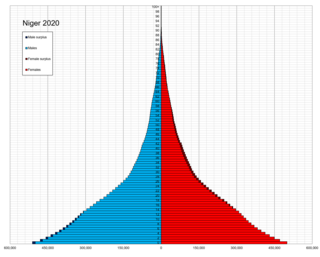
The demographic features of Nigeriens, the people of Niger consist of population density, ethnicity, education level, health of the populace, economic status, religious affiliations and other aspects of the population.

Bathinda district is in Malwa region of Punjab, India. The district encompasses an area of 3,385 square kilometers. By area, Bathinda district is the second-largest in Punjab, after Ludhiana district. It is bounded by Faridkot district and Moga district on the north, Muktsar district on the west, Barnala and Mansa districts on the east, and the state of Haryana on the south. Bathinda is cotton producing belt of Punjab.

Kapurthala district is a district of Punjab state in northern India. The city of Kapurthala is the district headquarters.

Prevalence of tobacco use is reported by the World Health Organization (WHO), which focuses on cigarette smoking due to reported data limitations. Smoking has therefore been studied more extensively than any other form of consumption.
This is a list of the States of India ranked in order of percentage of people exposed to the media. This information was compiled from NFHS-4. National Family Health Survey (NFHS) is a large-scale, multi round survey conducted by the International Institute of Population Sciences (IIPS), Mumbai designated by the Ministry of Health and Family Welfare (MOHFW), Government of India. National Family Health Survey (NFHS-4) was based on year 2015-16 and the detailed survey can be viewed in the following website.
The following are international rankings for Iran:

Barnala is one of the districts of Indian state of Punjab. It was carved out of Sangrur district, in November 2006. It is a centrally located district bordered by Ludhiana district on the north, Moga district on northwest, Bathinda district on west, Sangrur district on east and Mansa district on south. As per census 2011, Population of District Barnala is 5,96,294. Barnala boasts a significant number of colleges that offer a diverse range of educational opportunities in fields such as engineering, arts, medicine, and commerce. Furthermore, the town is renowned for its thriving industrial sector. Two main Industries: Trident Group and a large Industry producing Combines, Standard Combines were also established here.
Despite India's 50% increase in GDP since 2013, more than one third of the world's malnourished children live in India. Among these, half of the children under three years old are underweight.

Non-vegetarian food contains meat, and sometimes, eggs. The term is common in India, but not usual elsewhere. In the generally vegetarian environment of India, restaurants offering meat and fish usually have a "non-vegetarian" section of their menu, and may include the term in their name-boards and advertising. When describing people, non-vegetarians eat meat and/or eggs, as opposed to vegetarians. But in India, consumption of dairy foods is usual for both groups.
The All India Institutes of Medical Sciences (AIIMS) is a group of autonomous government public medical universities of higher education under the jurisdiction of Ministry of Health and Family Welfare, Government of India. These institutes have been declared by an Act of Parliament as Institutes of National Importance. AIIMS New Delhi, the forerunner institute, was established in 1956. Since then, 24 more institutes were announced.
The National Family Health Survey (NFHS) is an India-wide survey conducted by the Ministry of Health and Family Welfare, Government of India, with the International Institute for Population Sciences serving as the nodal agency.






